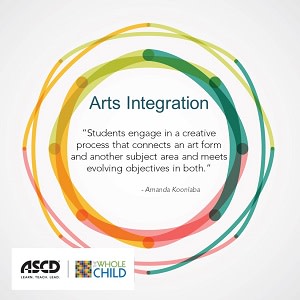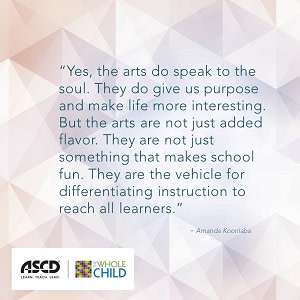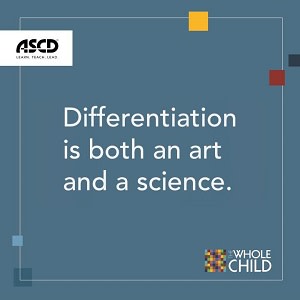So many of today's most pressing problems—from environmental disasters to the threat of future pandemics—call for science-based solutions. But are we doing enough to raise the next generation of world-class scientists? A look at the evidence suggests we are not.
About a third of elementary and middle school students hit the proficient mark in science on the latest Nation's Report Card, and U.S. teachers report spending far less time in science than other core subjects like reading and math. But simply adding more of the same—disconnected lessons that aren’t aligned to rigorous standards and don’t include hands-on and real-world learning opportunities—won't get the job done.
We must rethink how we teach science, applying a heavier focus on foundational skills and adopting a high-quality curriculum. Most importantly, we need to make science more engaging and applicable to issues kids care about. To do this, instruction should encourage kids to take on the role of scientists and build their scientific identities and passions.
Instruction should encourage kids to take on the role of scientists and build their scientific identities and passions.
Opening Doors for Every Student
One approach to building students’ scientific engagement is to encourage kids to participate in science competitions, which can build subject-matter knowledge and help students acquire a host of vital skills like presenting, storytelling, and more. As a National Geographic Explorer, a high school science research teacher, and a mentor to students who compete in a multitude of science fairs, I have seen firsthand how science fairs can positively impact students.
In general, elementary school students get minimal opportunities to participate in science competitions, and from what I have observed from middle and high school students, opportunities are more likely to exist in wealthier, better-resourced communities than those serving low-income and underrepresented families. This is consistent with access to STEM. According to a report by the Education Commission of the States, at every stage of their K-12 education, students who attend the highest-poverty schools are least likely to have access to STEM resources and experiences.
This is a disservice. All students, regardless of age, zip code, or family background, should have access to science competitions. For starters, preparing for and entering them can improve students' motivation to learn, which is hugely important given reports of declining student engagement and chronic absenteeism.
Consider the case of one of my former students who skipped school constantly because he was spending a lot of time running a business. He had poor grades, and his educational future was at risk when he came to me as a sophomore. However, he wanted to attend my class and participate in science competitions. After talking, we made a deal: He agreed to start attending all his classes regularly, and I supported his business endeavors by suggesting he hire an executive assistant. I also agreed to help him compete in science competitions by working with him after school and during weekends. In time, he began to thrive in school and produced a competitive research project about designing efficient glass windows that absorbed and released heat using solar technologies. He did not take the top prize at the prestigious contest he entered, but he did well and went on to attend one of the top universities in the nation. Today, he is an extraordinarily successful entrepreneur who uses many of the skills he learned in my science research class.
Besides the potential to motivate students, science competitions have many other benefits. Here are a few.
Science competitions can build subject-matter knowledge and help students acquire a host of vital skills like presenting, storytelling, and more.
4 Ways Science Competitions Inspire Growth
1. They can spark personal connections to the research.
One of my recent graduates has a deep understanding of cell biology after preparing for and earning a spot as a finalist in the prestigious 2023 Regeneron Science Talent Search. She submitted a paper on a potential genetic mechanism that induced spontaneous regression in childhood cancer (neuroblastoma). The issue was deeply personal to her, having survived cancer as a young girl and having lost a close friend to the disease. It is that type of connection to learning and problem-solving that science competitions can help ignite.
2. They connect subjects in interdisciplinary ways.
The student who studied childhood cancer did not have much computer science experience before entering the competition, but she sought help from mentors at an organization I run, the iResearch Institute, to learn code for her project. In addition to skills like coding, students can also improve their literacy and math skills as they read academic journals, engage in academic writing, and analyze data.
3. They improve speaking, listening, and critical thinking skills.
I have seen incredibly shy students light up and eloquently speak when presenting their research to judges. Students review each other’s projects and sometimes compete together, making science fairs a wonderful way to boost collaboration. There is perhaps no better way to improve critical thinking skills than by asking students to contemplate a real-world problem and produce a research-based solution to address it.
4. They open doors to other key opportunities.
Many of my students have been featured in prominent science journals, have gone on to medical school or PhD programs, and are shaping the science industry in their professions today. All kids deserve those kinds of chances in life. Currently, I'm working on an effort partially funded by the National Geographic Society called the Hidden Prodigy Project to bring such opportunities to students from underestimated, underserved, and underrepresented backgrounds by helping them enter and succeed in science competitions and providing them with mentors and other resources.
How to Start Competing
There are many ways to support your students in entering science competitions. I recommend looking into local competitions as a start. A few examples for middle-schoolers include the Toshiba ExploraVision, Thermo Fisher Scientific Juniors Innovator Challenge, and 3M Young Scientist Challenge. For high school, the Regeneron Science Talent Search, the Regeneron International Science and Engineering Fair, and the Junior Science and Humanities Symposium are a few good ones.
To develop project ideas, ask students to identify science-related issues that are important in their communities. For example, in my school’s community, an Environmental Protection Agency Superfund site exists. Superfund sites are designated as the most contaminated sites in the country. My students have been passionate about looking at the environmental and biological impacts of such sites and ways to address the ramifications of these sites on the community. You can also reach out to your broader school community for help. Start with parents who work in science-related fields and with STEM organizations in your area.
A little competition goes a long way to helping students become the critical thinkers, problem solvers, and scientists that the world desperately needs.
If competitions are too daunting, you can help students organize public presentations of their work to a broader audience. Team up with your colleagues to run in-school science fairs that address science-related issues in the community and bring in scientists for in-person or virtual visits. This can be great for elementary, middle, and high schoolers. National Geographic Explorers love zooming into classrooms worldwide through the Explorer Classroom program. Having been involved with several of those, I am always impressed with the great participation and questions we get from students. Some questions are highly technical, showcasing the degree to which the kids have been engaged and listening to the talk. Others focus on understanding the Explorer's professional career path. You can see the kids building their own scientific identities and futures in those exchanges.
Embracing Healthy Competition
I know there is a push in many places toward making U.S. schools less competitive. But when it comes to science, a little competition goes a long way toward creating educational opportunities for students and helping them become the critical thinkers, problem solvers, and scientists that the world desperately needs.
Serena McCalla, Ph.D., has served as the science research coordinator at Jericho High School in Jericho, N.Y., and is a National Geographic Explorer. She was featured in National Geographic's Emmy-award-winning Documentary "Science Fair" and a television series of the same name. Serena founded iResearch Corporation, which supports students in conducting science research and entering science competitions and created the Hidden Prodigy Project with the support of National Geographic. She serves on the board of directors of Great Minds PBC, the developer of the PhD Science curriculum, Eureka Math, Wit & Wisdom ELA.








